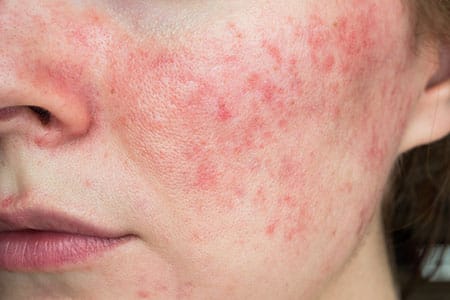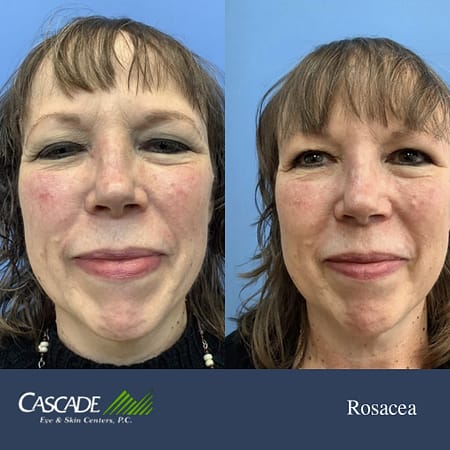Rosacea is a chronic inflammatory skin disorder that primarily affects the face and is characterized by flare-ups and remissions. Often beginning after the age of 30, individuals affected by rosacea may experience facial flushing and irritated skin. Rosacea is relatively common but may often be misdiagnosed as other conditions.
Rosacea Symptoms
Rosacea is more common in women than men, and it usually begins with facial redness around the age of 30. Over time, the redness tends to become more persistent, and visible blood vessels may become noticeable. The skin of the affected areas may also feel hot and tender, like a burning sensation. Left untreated, bumps and pimples that resemble acne may form, and in severe cases, the nose can grow swollen and bumpy due to excess skin tissue. In many rosacea patients, the eyes are also affected, leading to:
- Dry, irritated eyes
- Crust around the eyelashes
- Swollen eyelids
- Watery or bloodshot appearance
Causes of Rosacea
Although the cause of rosacea is unknown, there are some theories about what might contribute to its development:
- Abnormalities in the blood vessels of the face
- An abundance of Demodex folliculorum, which is a microscopic mite present on the skin
- Family history
- Overactive immune system
Rosacea may also be triggered by external factors like:
- Alcohol consumption
- Vigorous exercise
- Exposure to UV radiation or wind
- Intense emotions
- Extreme temperatures
- Drugs that dilate blood vessels
- Spicy foods
Treatment for Rosacea
At Cascade Eye & Skin Centers, our dermatology providers tailor a treatment plan to each patient’s individual signs and symptoms of rosacea.
Oral and Topical Medications
Various oral and topical medications are available to treat rosacea symptoms. These types of medications especially help the inflammation of bumps and pimples. Topical medications may be in the form of lotions, creams, gels, or ointments.
Laser Treatment
Cascade Eye & Skin Centers utilize intense pulsed light (IPL) to decrease redness, correct disfigurement of the nose and diminish the appearance of visible blood vessels.





